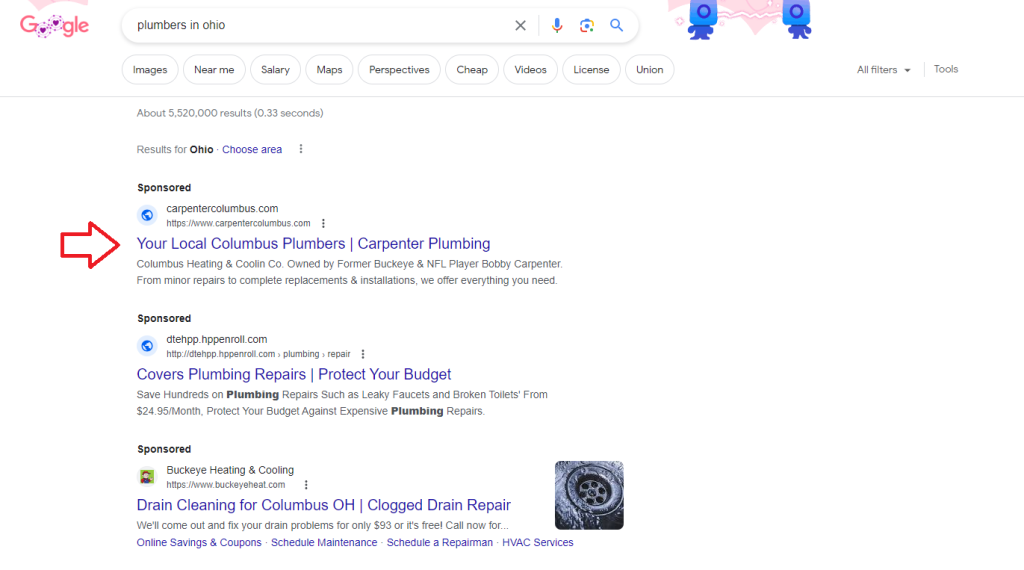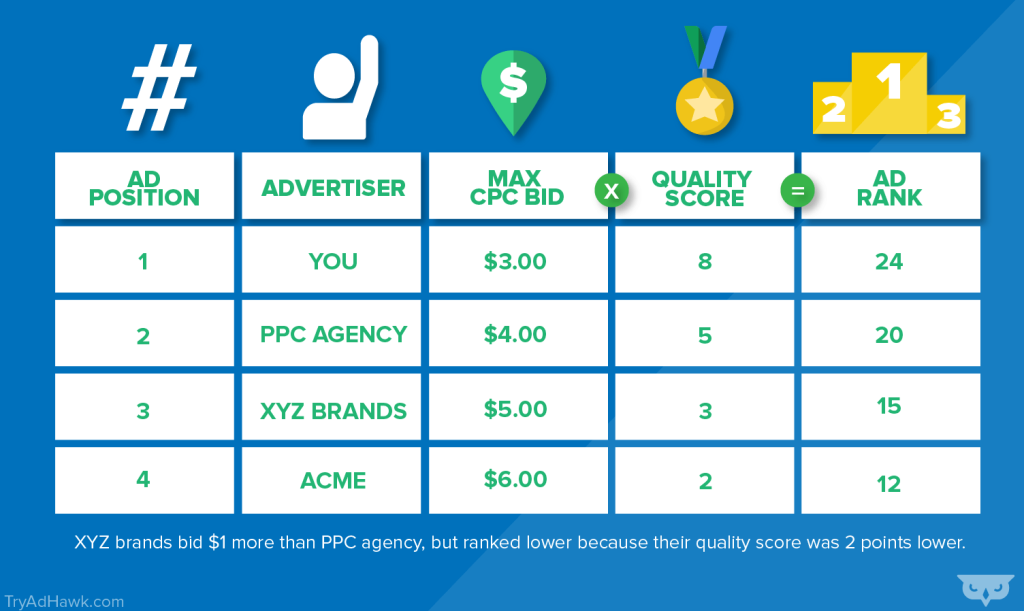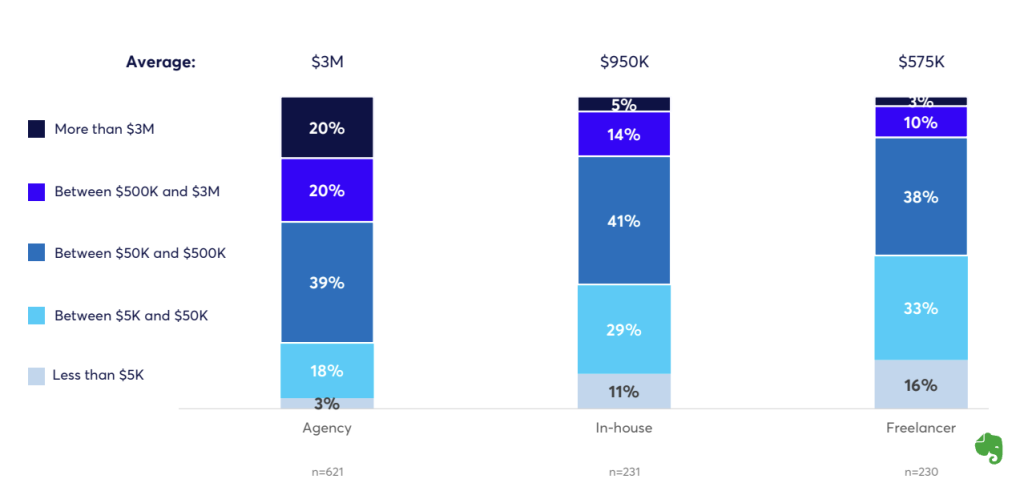PPC Pricing – What Does PPC Cost in 2025?
Editor’s Note: This post was originally published in March of 2020 and has been updated for accuracy and comprehensiveness.
PPC advertising is what it sounds like.
It is a form of advertising in which you pay per ‘click’ that you receive. This can be on search engines such as Google or social media platforms like LinkedIn. Overall, it’s an effective marketing strategy to attract targeted traffic and increase revenue for your business.
However, PPC isn’t as simple as it used to be. Today’s campaigns rely on signal-based automation – smart systems that use data to optimize ad performance and generate conversions. You need enough budget to generate the data to fuel these systems.
In this article, I’ll talk about PPC and how much you should budget for your ad campaigns in 2025.
How does PPC placement work?
PPC placement depends on the relevance of your ad to the user’s search query. Google, for instance, wants to cater to search intent and rank ads that “closely match what customers are searching for.”

For example, if a user searches for “plumbers in Ohio,” the ads shown are closely related to the target keyword:

Other factors come into play, too. One of the most important is the Ad Rank – a set of values that determine if your ads are eligible to show on the search results and where they’re displayed.
The Ad Rank score is calculated based on:
- Context of the search query.
- Ad and landing page quality (quality score – QS).
- Competition.
- Bid amount.
For example:
A $5 maximum bid with a QS of 10 gives you an Ad rank of 50.
Ads with the highest ad rank get the highest placement on the search results.
See the illustration below:

Google also assigns a quality score to measure the quality of your ads and landing pages. This score is reported on a scale of 1 – 10, and the higher your quality score, the lower your CPC.
So…
How much do you pay if you win the auction and your ad gets listed on the search results?
Google uses a simple calculation to determine your cost per click. That is, your ad rank of the ad below yours, divided by your quality score (QS), then multiplied by one cent.

How much should you budget for PPC?
There’s no fixed amount for how much you should spend on PPC.
Usually, your budget depends on your business revenue, goals, customer lifetime value, and industry benchmarks. According to the state of PPC report 2024, about 39.33% of companies spend $50,000 to $500,000 per month on PPC.

Here’s a simple way to set a budget for your PPC campaigns:
Step 1: Determine the average order value.
The average order value (AOV) is a metric that measures the amount of money each customer spends on a single order. In a sentence, your AOV is the average value of a sale.
To calculate AOV, divide your total return on ad spend (per month, quarter, or year) by the number of orders during this period. In this case, let’s assume that your AOV is $2000.
Step 2: Calculate your target customer acquisition cost (CAC).
Next, calculate the amount you’re willing to spend to acquire new customers. This is called the target customer acquisition cost. For example, your CAC can be 10 or 20% of your revenue.
Step 3: Identify the lead-to-sale conversion rate:
The lead-to-sale conversion rate is a metric that measures how many leads convert to paying customers. For example, if you close 1 in 10 leads, your lead-to-sale conversion rate is 10%.
Step 4: Calculate the cost per lead:
Cost per lead is the amount of money you pay per lead generated from your ads. To calculate this score, divide your customer acquisition cost (also called cost per acquisition) by the lead-to-sale ratio.
Following our example, let’s assume the CAC is $500 and the lead-to-sale is 10. This means the cost per lead is:
$500/10 = $50
Step 5: Multiply the leads by volume
Now that you know the cost per lead, calculate how many leads you need to reach your goals. For example, if you want 50 new customers, you’ll need 500 leads/month.
This means your ad budget will be:
500 leads x $50 = $25,000.
This is just a simple framework to budget your ad spend.
How much should you pay for PPC in 2025?
It depends on the level of support and expertise you need.
If you’re running ads in-house, your main costs will be the ad spend itself and the time your team invests in managing the campaigns.
But if you decide to work with a PPC agency or specialist, expect to pay more. This is because these experts understand how to optimize ad spend and improve your ROAS.
For instance, it costs between $10,000 to $50,000 to hire a PPC agency on Clutch. Keep in mind that this cost varies between vendors, depending on their pricing model. To save costs and avoid throwing your bucks down the drain, choose agencies that offer performance-based or hybrid pricing.
Here’s why:
In performance-based pricing, you only pay for results instead of impressions. This can be leads, conversions, sales, or ROAS.
Hybrid pricing, on the other hand, offers a middle ground between fixed and performance-based pricing. You pay a base monthly retainer for account management, and a performance bonus tied to KPIS like ROAS or number of leads generated.
Both pricing models ensure that you pay for results that impact the bottom line instead of vanity metrics.
Other key factors that influence PPC costs are:
i. Scope of services: Do you need comprehensive digital marketing services or just PPC? If you need to create a landing page, set conversion tracking, copywriting services and A/B testing, it attracts more costs. More services equal extra time, tools, and expertise.
ii. Ad channels: How many channels are you advertising on? Each platform has its own unique strategy and optimization process. So, a multi-channel strategy will cost more in both ad spend and management fees.
iii. Ad expert experience level: PPC experts charge more because of their years of industry knowledge and battle-tested PPC strategies. However, their fees are justifiable because of the ROAS, which offsets the initial costs.
iv. Goals: The more aggressive your business goals, the higher your budget needs to be. For example, if you want to double your customer base in three months, you’ll need to increase your budget to expand your visibility.
v. Search engine updates: Recently, Google announced that it would offer web users the opportunity to “opt in or out” if they need third-party cookies on their web browsers. In their own words:
“Instead of deprecating third-party cookies, we would introduce a new experience in Chrome that lets people make an informed choice that applies across their web browsing, and they’d be able to adjust that choice at any time.”
What does this mean for your business?
Privacy restrictions will make it more challenging to track potential customers (especially for remarketing ads). This means you have to pay more to find people interested in your business. I’ll discuss more on this later.
What does a basic PPC campaign cost?
Basic PPC packages should cover an ad spend of up to $2,500 and include up to 400 keywords in the campaign. With this budget, you can hire an agency to manage your PPC campaigns to increase your return on ad spend. This budget covers Google ads only, and is perfect for:
- Search ads (text-based ads shown on Google search results).
- Display ads (banner or visual ads across Google’s Display Network).
- Remarketing ads (targeting your previous website visitors who didn’t convert).
You can also run YouTube video ads under a basic plan. However, you would have to make the video in-house since it’s not a service offered with basic campaign management.
What does something like this cost?
Most agencies will charge a one-time setup cost of around $1,000 to get started on a basic plan. After that, the monthly management costs will be about $400–$430. Keep in mind that this cost increases by 10% YoY, so plan your budget accordingly.
What do you get for that money?
Basic PPC management services include:
1. Competitor analysis:
Here, the agency will look at your paid search competitors to see:
- What keywords they bid for.
- Their ad copy and format.
- Opportunities to differentiate or outrank this.
This data will help to shape your own campaign strategy for better results.
2. Campaign development and strategy
Usually, this is the most essential and first step of your ad campaign. The PPC agency will create a custom plan to ensure every dollar spent is optimized for results – traffic, leads, or sales.
This includes:
- Defining your target audience and segmenting them based on behaviours, demographics and intent.
- Identifying the best time frames to run your ads for maximum visibility.
- Checking previous ad campaigns to see what worked and didn’t.
- Selecting an Ad platform (search, display, or remarking).
Why is this important?
Let’s use one of our clients as a case study. Allure Bridals is an award-winning bridal manufacturer with over 100 retailers across the world. Their challenge? To get more customers and increase reach via paid search.
The first thing we did was to examine their previous campaigns to discover key insights such as:
- Their current market performance.
- Target demographics.
- Areas where they’re losing visibility.
This helped inform our campaign strategy, and as a result, we generated over 25.36% in click-through rate after the campaign ended.
Check out the full case study here.
3. Keyword research
Keyword research is the foundation of any successful PPC campaign. This process ensures that your ads are shown to the right people and at the right time.
The agency will identify high-converting keywords that your target audience is actively searching for, as well as the negative keywords that should be excluded to avoid wasting your ad spend. This data will inform other vital parts of your ads, such as copy, groups, and setting bids. Your agency will also tone your ad budget up or down depending on the value of the keywords.
4. Industry analysis
Industry analysis is a comprehensive assessment of your market, including your competitors, to inform and optimize your ad campaigns. Before your ads go live, your PPC agency will conduct an industry analysis to identify:
- Rising trends in the industry that you can capitalize on.
- Shifts in user behavior, such as changes in search patterns.
- Seasonal changes that affect how people search or buy.
- Benchmark performance data to guide realistic expectations.
This data enables them to understand the market dynamics and identify opportunities for better, effective results.
For example, if you’re in the B2B industry, your agency will monitor market shifts like how C-suite executives search for solutions online, the type of content they consume, and the platform they use the most. With this, they can adjust the ad campaign to align with your buyer’s journey.
5. Ad copywriting
Every ad needs a compelling copy.
Even if you’re topping the paid search results, your ad copy determines if your potential buyers will choose you or the competition.
Your PPC agency will create an optimized, user-centric ad copy for your landing page. This may also require A/B testing to find the best-performing copy.
Tip: When choosing a PPC agency for business, prioritize industry specialists rather than generalists. For instance, if you own a law firm, focus on agencies experienced in running law-related campaigns. Specialized agencies understand your target audience better and know how to create compelling ads that make them click.
6. Performance testing
Performance testing is the backbone of any PPC campaign. It gives you a full understanding of what’s working and what’s not, so that you can improve on subsequent campaigns and generate higher ROAS. Luckily, the basic PPC services cover this.
Your PPC agency will monitor the campaign after it goes live to see if it’s driving the desired results. For example, say your ad is getting plenty of clicks but no conversions. This can be a result of a poor landing page experience or subpar copy that doesn’t align with user search intent. Performance testing helps to reveal these weak points for improvement.
7. Ongoing campaign development
This is another post-campaign task. The agency will stay on top of keyword trends to keep your campaign up-to-date. This involves checking keywords, bids, and budgets, optimizing for improvement.

Take, for instance, user search patterns. This evolves over-time, and what worked last year may not be effective for 2025. It’s your PPC team’s job to identify these shifts early and update your campaign accordingly.
Other campaign management tasks include:
- Identifying keywords that lose traction.
- Adjusting bids based on keyword performance and competition.
- Allocating more spend to top-performing campaigns while cutting down the underperforming ones.
- Testing new headlines, descriptions, and calls to action to improve engagement.
- Ensuring that the ad matches the user’s search intent.
8. Google Analytics (GA4) integration:
For effective monitoring, you also need to know what users do after they land on your site. This is where Google Analytics 4 (GA4) comes in.
With GA4, you can:
- Track conversion events more accurately. That is, if your visitors convert, bounce, or engage with your content.
- Attribute conversions across multiple touchpoints.
- Segment your audience by location, device, engagement level and traffic source.
- Better understand user behavior, such as how long they stay on your website and where they drop off.
- Visualize the user journey from ad click to final conversion.
Think of it this way: While Google Ads will provide you with reports, GA4 makes it easier to understand the relevance of those reports and how to use them to improve your campaigns.
9. Goal tracking
Every successful PPC campaign starts with one question: What does (or will) success look like?
From the outset of the client-agency partnership, ensure you define clear, specific goals for the ad campaign. This can be to increase brand visibility, sales, or traffic. This will help the agency create a results-focused strategy that improves the bottom-line.
Also, goal-setting helps you track progress against specific outcomes, instead of surface-level metrics such as clicks or impressions. They’ll monitor metrics like:
- Conversion rates based on your main key performance indicators (KPIs).
- Cost per acquisition (CPA) to ensure your budget is spent efficiently.
- Return on ad spend (ROAS) to know how much revenue is generated from your ad spend.
10. Strategic management of bids
Bid management directly influences your ad placement, visibility and spend.
Technically, your bid strategy can mean the difference between a successful campaign and one that fails. It determines:
- How often your ads appear.
- Where they show up on the paid search results.
- Who sees them.
- The kind of engagement you generate.
Your PPC agency handles your bid strategy. They will:
- Monitor your bid performance in real time.
- Adjust bids based on budget, goals and competition.
- Test and optimize to improve ROAS.
In a sentence, the agency works with your budget to ensure you get the most value on every dollar spent.
Lastly..
11. Analysis and reporting of results
PPC is an investment. And just like any other investment, you should know how it’s performing to improve future outcomes.
So, look out for:
- Performance report containing key metrics such as ROAS, CPA, conversion rate, and clicks.
- An in-depth explanation of how your budget is allocated and why.
- Trends, opportunities and weaknesses to capitalize on for better results.
This is where most agencies fall short. If the reporting is vague, overly technical, or not included in the list of services, it’s a red flag. Instead, go for an agency that provides transparent, data-driven reporting for your PPC campaigns.
For instance, at Higher Visibility, one of our hallmarks of PPC management is transparent, client-driven reporting. We provide each client with access to a 24/7 real-time dashboard where they can track performance, spend, and campaign insights in real time.
We also assign a campaign manager who helps them oversee their ad campaigns and provide help/explanation when necessary. This level of transparency builds trust and allows our clients to make smart, informed decisions over their PPC campaigns.
What does a moderate PPC campaign cost?
A moderate PPC campaign should have a monthly ad spend between $2,500–$12,000. It usually features up to 2,000 keywords in the campaign.
A moderate campaign includes everything involved in a basic PPC campaign. It also comes with additional conversion monitoring and checking for fraudulent activity, for example, click fraud.
Also, the agency sets up and manages rule-based bidding, where the bid examines each keyword independently, rather than looking at how they might work together.
For a moderate PPC campaign, an agency will charge a setup fee in the first month of $1,750. It would then be around 15% of the monthly ad spend, with a minimum of $500.
Tip: When you’re creating a more expanded campaign, run ads in both the Google and Bing Ads networks. While Google is a much more extensive network, it doesn’t hurt to cast a bigger net.
What does an aggressive PPC campaign cost?
An aggressive PPC campaign is generally considered a monthly spend of $12,000– $50,000. PPC cost per project can vary based on factors such as project scope, requirements, and the experience of the service provider.
Many businesses pay between $1000 to $5000 for a project, while more complex projects can exceed $10,000.
It can include up to 10,000 keywords and is conducted on both the Google AdWords and Bing Ads networks. An aggressive PPC campaign involves everything included in the above levels but adds international management. This is a huge plus for companies that do business outside the U.S. This level also includes landing page creation and conversion rate analysis.
In addition, an agency-managed campaign at this level should also include graphic design of visual content. You should get at least one set of banner ad designs for display and remarketing campaigns. This will cost a $2,500 one-time setup fee. After that, you’re looking at a base monthly price of 12% of your monthly ad spend, with a minimum of $1,800.
How much does PPC retargeting cost?
Have you ever noticed that once you visit a website, you start to see ads for that brand popping up all over the place? That’s not a coincidence. It’s retargeting at work.
Retargeting involves showing your ads to people who have visited your site and left without making a purchase.

When you dig down into the visitor metrics, most websites tend to have a high bounce rate, with 41 -51% of visitors clicking off your site after a few seconds.
What’s more, even though shoppers tend to pile up their online carts, 70.19% of purchases are never completed. Retargeting gives you a second chance to get in front of the customers who drop off to try and win them back. It’s equally a great way to lure back prospects who initially showed some interest in your company but didn’t convert for one reason or another.
Plus, since you’re targeting customers who have already shown an interest in your brand, this can help to reduce advertising costs and improve ROAS. Rather than trying to convince a brand-new prospect, these potential customers are already on their way to buying.
This is why 1 in 5 marketers have a retargeting budget to optimize the overall efficiency of their paid ad campaigns.
But how much of your budget should be allocated to retargeting?
The remarketing cost varies based on industry, much as we discussed earlier. If you have a ton of competition, you’ll pay a lot for every click. However, companies with light to moderate competition usually see between $0.66 and $1.23 per click.
Tip: All levels of PPC management services should include ad retargeting.
Why Signal-Based Automation is the New Norm for PPC Advertising
According to Adweek, approximately 40% of the web traffic operates without third-party cookies. This is likely due to Google’s initial plan to deprecate cookies to improve user privacy. This means advertisers engaging in retargeting will need to source customer data via other alternatives such as first-party data.
Signal based automation in advertising utilizes user behavior and other data points (signals) to:
- Deliver personalized ad messages.
- Improve campaign effectiveness.
- Improve customer experience.
These signals can be website visits, social media interactions, or even purchase history – anything that can inform your ad campaign.
With signal based automation, marketers and advertisers can retarget potential customers without relying on third-party data.
This involves:
- Combining first-party and advertising data to gain a comprehensive view of your target audience.
- Use advanced AI and automation to achieve better ROAS with minimal manual effort.
- Develop targeted audience profiles to create personalized ad campaigns.
Conclusion
PPC is a great way to get your website out there using both the Google Display and search networks. By setting a reasonable bid budget and creating quality PPC ads, you’re more likely to succeed and gain more clicks.
That’s why it’s so important to entrust your PPC digital marketing to a skilled agency staffed with pay-per-click marketing professionals. Now that you know what average PPC pricing looks like, talk to HigherVisibility about managing your PPC campaigns today.
